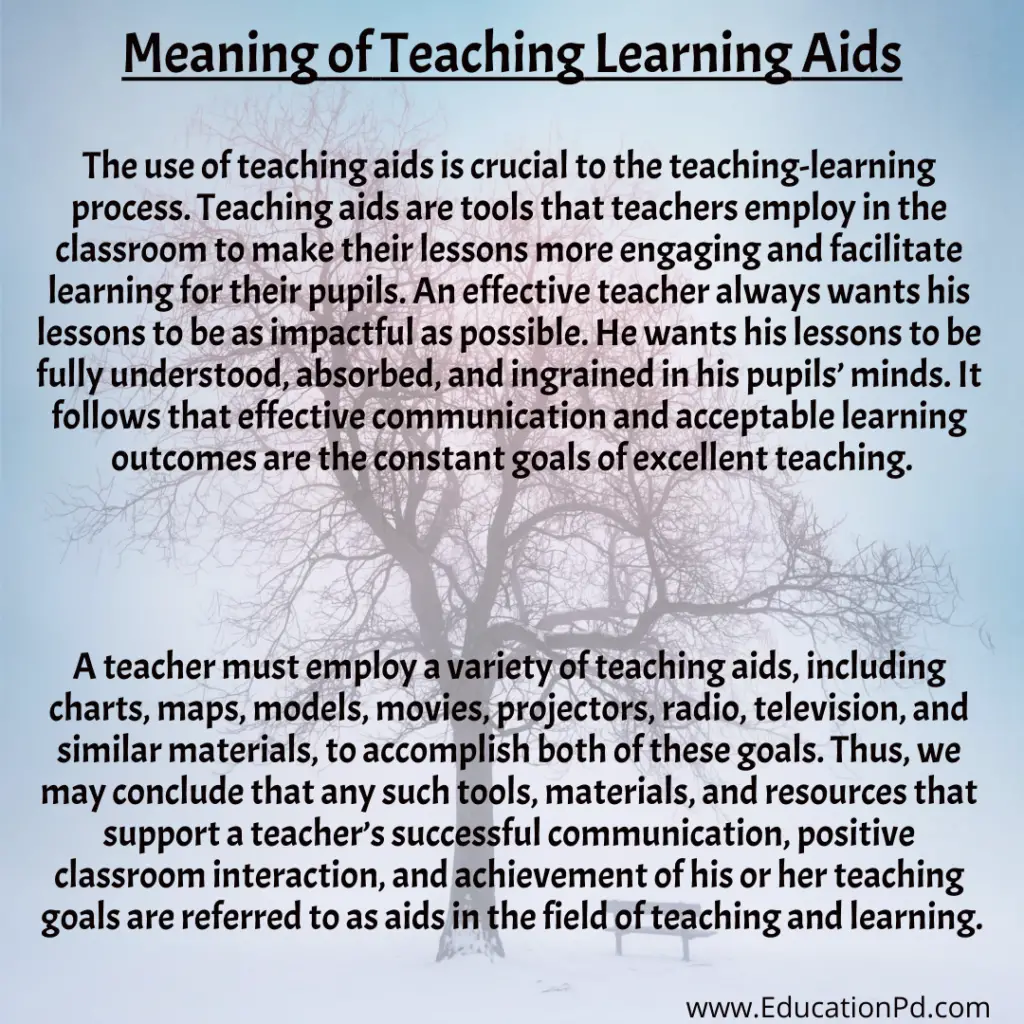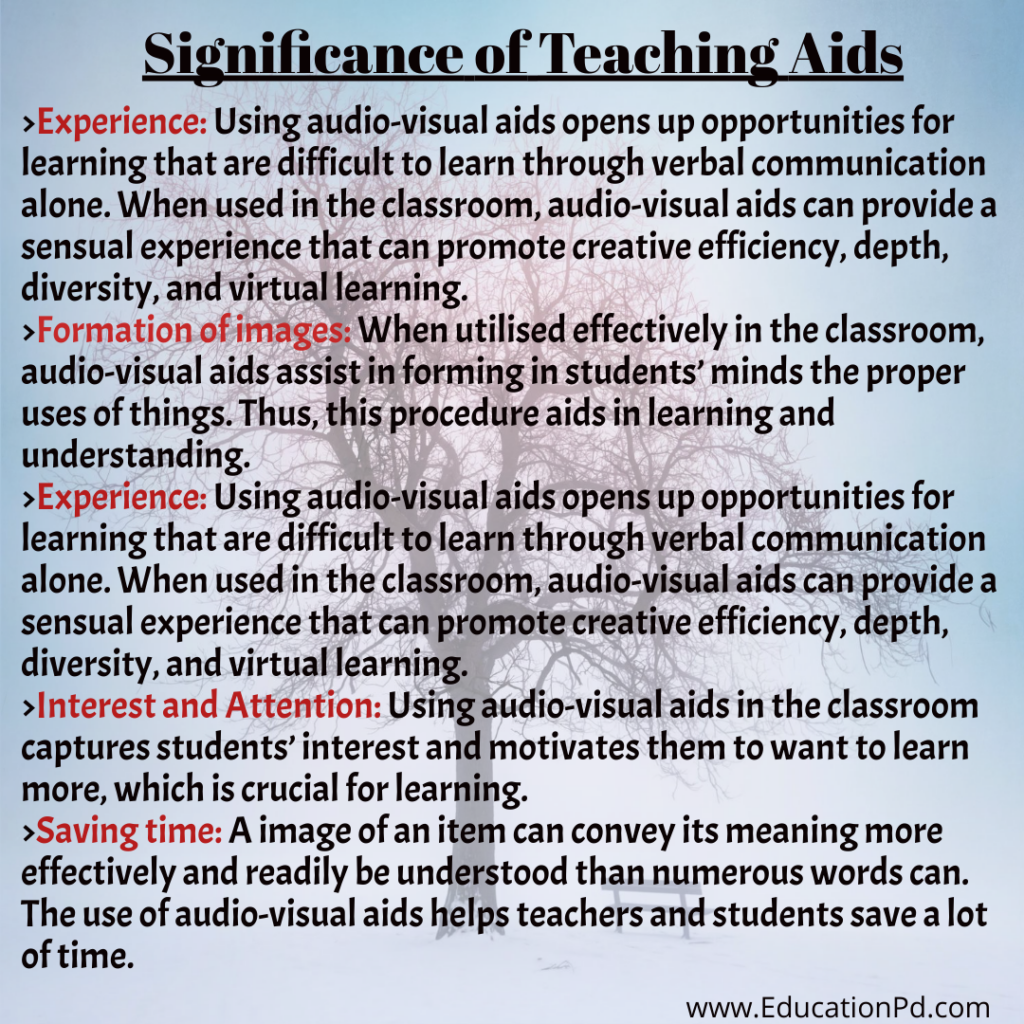Back to: Educational Technology in Education B.ed Notes, M.A Notes, IGNOU Notes
Meaning and Significance of Teaching Learning Aids
Meaning of Teaching Learning Aids
The use of teaching aids is crucial to the teaching-learning process. Teaching aids are tools that teachers employ in the classroom to make their lessons more engaging and facilitate learning for their pupils. An effective teacher always wants his lessons to be as impactful as possible. He wants his lessons to be fully understood, absorbed, and ingrained in his pupils’ minds. It follows that effective communication and acceptable learning outcomes are the constant goals of excellent teaching.
A teacher must employ a variety of teaching aids, including charts, maps, models, movies, projectors, radio, television, and similar materials, to accomplish both of these goals. Thus, we may conclude that any such tools, materials, and resources that support a teacher’s successful communication, positive classroom interaction, and achievement of his or her teaching goals are referred to as aids in the field of teaching and learning.

Significance of Teaching Aids
- Motivation: It’s important to inspire all of your pupils when you’re teaching. Throughout the creation of the lesson, several of them continue to be withdrawn. Even while everyone is expected to benefit equally and pass the same exam, only a select few students are genuinely motivated, able to pay close attention in class, and willing to contribute to the advancement of knowledge. There is therefore a pressing need to inspire the children to learn. participation. It’s crucial to use audio-visual tools to inspire kids.
- Reality: By employing audio-visual aids like photos, charts, maps, and models, the classroom may show the reality of the material that will be taught there. Incorporating these into lessons helps infuse the classroom with reality.
- Concept formation: The main components of concept formation are thinking and reasoning. Concept creation can be facilitated by using audio-visual aids that minimise verbalism and encourage thought and reasoning through elicitations. This aids with conceptual understanding as well.
- Interest: As students are constantly drawn to items they can see, hear, touch, taste, and smell for themselves, audio-visual aids can effectively and timely respond to their high levels of interest. The kids are always driven by an interest in the plot, improvising, and attempting to create.
- Developmental learning: Learning should always be developing. The kids are unable to comprehend everything at once. Slowly, they pick things up. And occasionally they pick up lessons from their errors. The foundation for developmental learning is provided by the use of audiovisual aids in the classroom, making the learning more lasting.
- The reality of experience: The employment of audio-visual aids in the classroom provides pupils with a reality of experience that encourages self-activity on their behalf. They develop self-confidence via self-activity.
- Thoughtfulness: If a lesson does not encourage pupils to think, it is not just a waste of time and effort but also damaging. Students who are taught solely verbally become passive listeners and acceptors. Instead of learning, they only continue to listen and receive. They are incapable of inventing or creating. Additionally, there is a connection between the educational process and memory-building. Reminiscence, which is essentially the process of education, can only be evoked and brought forth through the thinking process. This goal can be accomplished by using audio-visual aids in the classroom. Their application fosters in pupils a continuity of thought that is essential for true education.
- Retention: The use of audio-visual aids helps pupils retain what has been taught to them in class over the long term. The process of retentivity is aided by audio-visual aids because they encourage pupils to respond as fully as possible to the environment in which they are taught and learn.
- Formation of images: When utilised effectively in the classroom, audio-visual aids assist in forming in students’ minds the proper uses of things. Thus, this procedure aids in learning and understanding.
- Experience: Using audio-visual aids opens up opportunities for learning that are difficult to learn through verbal communication alone. When used in the classroom, audio-visual aids can provide a sensual experience that can promote creative efficiency, depth, diversity, and virtual learning.
- Interest and Attention: Using audio-visual aids in the classroom captures students’ interest and motivates them to want to learn more, which is crucial for learning. The use of audio-visual aids encourages students to think critically and take action while enhancing the knowledge taught in the classroom.
- Saving time: A image of an item can convey its meaning more effectively and readily be understood than numerous words can. The use of audio-visual aids helps teachers and students save a lot of time. Several modern devices, such as overhead projectors, film projectors, and film strip projectors, save teachers’ time and resources.
Today’s schools are increasingly utilising educational technology, which has freed up teachers from the mundane task of imparting knowledge and allowed them to focus more time and energy on tasks like organising, designing, and assessing learning experiences as well as mentoring and counselling students. Instead of using an instructor, several electronic means are employed to precisely and effectively deliver factual knowledge. Students nowadays thus learn through a variety of mediums. Another obvious trend is the development of multi-media learning environments in the classroom that employs a range of connected learning experiences. The employment of appropriate sequences of interconnected audiovisual or instructional media learning experiences that reinforce and improve the learner’s progress” is implied by this.

